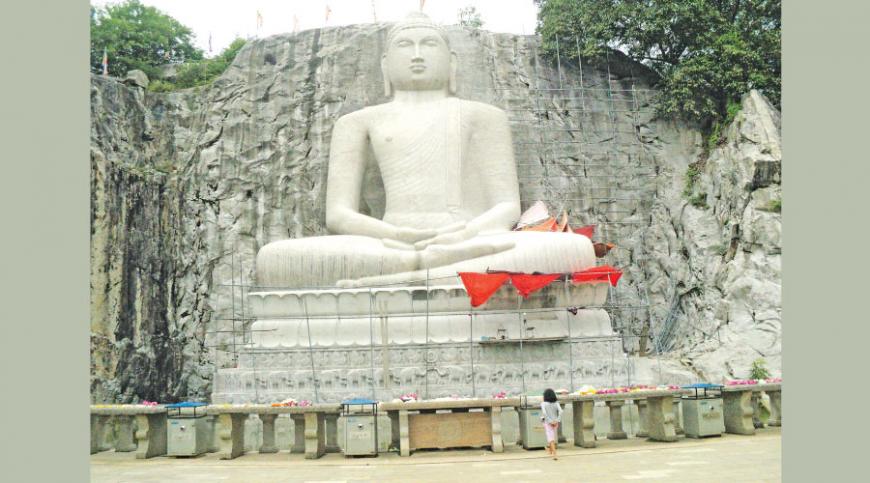
Kurunegala is an ancient city in the North Western region of Sri Lanka that was once the capital city used by four different kings who ruled over our island nation for around 50 years. Today, the city has become the administrative capital of the North Western Province. Located about 94 km away from Colombo, 54 km away from Kandy, 54 km away from Puttalam and 121 km away from Anuradhapura; Kurunegala is a transportation hub that connects many roads leading to all parts of the country.
Because Kurunegala is located within the “Coconut Triangle”, this area is famous for coconut plantations. The terrain is flat; but, the landscape is highlighted by large rock formations. There are nine such rocks surrounding the city. Interestingly, the shapes of seven of these rock formations resemble animals. Thus, it is not a surprise that our ancestors named them after the animals the rocks resemble. The largest rock is ‘Athugala’, standing 325 metres tall and resembling an Elephant. Built atop Athugala, is a large Buddha statue that stands 88 feet tall.
If you’re travelling from Kandy, turn right at the roundabout in the town and continue for about 50 metres. You will then come across the ‘Athugala Road’ on your right. Finally, a 30 minute hike will get you from the bottom of the rock to the peak where a breathtaking bird’s eye view of the town, the lake and the other surrounding rocks, await you.
If you are not keen on walking, do not lose heart, the Atugala road is carpeted and motorable up to the peak. Much like Athugala, many of the other rocks are crowned with white Dagobas visible from a fair distance. Situated below Athugala is an ancient Buddhist temple known as ‘Athkanda Viharaya’. It is said that the fabled Jathaka stories were composed at this historic temple. The temple is located on the left hand side of the Kandy-Kurunegala main road in the vicinity of the Kurunegala town.
Close to the centre of the town is a large reservoir of water constructed by ancient kings. Known today as the Kurunegala Lake, it is located about 500 metres along the Dambulla road. The circular road that runs around the lake has been well paved and given a face lift along with the addition of a jogging track. The area is well patronised by locals and visitors who come to enjoy the scenery and relax. The far side of the lake is the perfect vantage point to capture a beautiful landscape photograph of the lake with the Buddha statue and Athugala in the background.
Based on the details written in the Mahawansa and according to legend, during King Dutugamunu’s reign (161-137 BC), there was a trail running through this area to the hill country. A merchant travelling on this trail had come across a sweet jackfruit (Peni Waraka) while resting in this area and offered it to an Arahat Thera residing in this area. After consuming the fruit the Thera had shown the merchant the direction to proceed. While proceeding on that track he had come across a cave with silver ore. He had taken a sample to the King and the King who was desperately searching for facilities to build the great stupa, had brought the silver back to his kingdom and used it to construct the Ruwanweliseya. In gratitude the King had built a temple encompassing the cave where the silver was found and called it the Ridiviharaya.
The spot where the silver was found is marked within the cave. The cave also serves as a shrine room. There is also a gedige type temple dating back to the Polonnaruwa era built entirely in stone. The roof rests on eight stone pillars. It is believed that this has been built at the place the merchant offered the jack fruit to the Arahat Thera. It is also known as the ‘Waraka Velandu Viharaya ‘- in Sinhala. To reach the Ridiviharaya, turn right at Mallawapitiya onto the Keppetigala road when travelling from Kandy to Kurunegala. After about 13 kilometres turn right at the sign board and proceed about 2 km to reach the Temple complex. While visiting the Ridiviharaya, you must also visit the Rambodagalla Buddha Statue; the largest rock carved Buddha statue in Sri Lanka. This statue is part of the Moneragala temple complex. From Ridiviharaya, go back to the Keppetigala road and proceed about 5 kilometres. The Monaragala temple is by the side of the main road to the right. The Moneragala Temple is an ancient temple which was quite unknown till the statue was built, after seeing the destruction of the Bahamian Buddha Statues in Afghanistan by the Taliban in March 2001, Ven. Amaramoli Thera, the chief incumbent of the temple, was determined to carve a Gigantic Buddha statue on the massive granite rock in the temple premises.
Work on this massive project started in September 2003 with financial assistance from devotees and mercantile establishments and technical assistance from Indian Artists. Today, this Samadhi Buddha statute stands 67.5 feet tall and is known to be the largest Rock carved Buddha statue in the world. The iconic statue was declared open by His Excellency the President of Sri Lanka on 30th April 2018.



